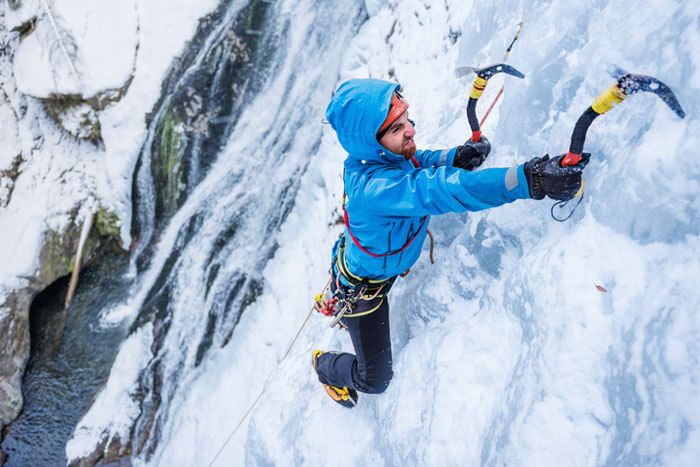- Details
- Written by: Nina
An ice axe is a key part of mountaineering equipment, especially for winter alpinists, ski mountaineers and ice climbers. You might think all ice axes are the same, but there is a lot of variation. You’ll need a different ice axe for mountaineering up Everest compared to ice climbing a waterfall in Canada.
Mountaineering Equipment Essentials: Our Guide To Basic Mountaineering Gear
We have already written guides on how to choose the best mountaineering boots, mountaineering gloves and mountaineering jacket. Now we are looking at hardware such as the ice axe. There are a number of things to consider before buying an ice axe, such as length, material and the shape of the pick. We would highly recommend taking a course before using an ice axe in the mountains. This article is intended as an introduction to ice axes.WHAT ARE THE PARTS OF AN ICE AXE?

HEAD
The head is made up of the pick, adze and the carabiner hole. The pick is used for hooking or swinging into snow/ice. It’s also the part of the ice axe used during self-arrest (when a climber falls and uses the axe to stop the slide). The adze is the flat end of the head that’s used for cutting blocks into the snow, like steps. The carabiner hole is used to clip a carabiner.SHAFT
The shaft is the main part of the ice axe that you grip onto. It’s usually made from either aluminium, carbon-fibre or steel. You have to choose whether you want a light or heavy shaft – heavier shafts are usually stronger.SPIKE
The spike is the sharp pointy end of the shaft. Mountaineers use it to keep balance while walking on snow or ice, like a trekking pole.Mountaineering Clothing: How To Choose Best Mountaineering Helmet?
HOW DO I CHOOSE AN ICE AXE THAT IS RIGHT FOR ME?

LENGTH
Ice axes vary in length from 50cm to 75cm. There are a couple of ways to decide which length is right for you. One way of determining this is by standing upright and holding the ice axe by the shaft while keeping your arms relaxed by your side. The ice axe should barely skim the ground. Generally, if you are under 5’8” tall, you’ll want a 50-60cm long ice axe. If you are taller than 5’8”, then try a 60-75cm ice axe. Axes under 60cm are sometimes called technical ice tools because they are used more for steep technical ice climbing.PICK SHAPE
There are three different types of pick shape: classic, neutral and reverse. The most common pick shapes are classic and reverse. A classic pick is great for self-arrest and climbing steep sections of ice but it can be quite hard to pull out of the ice. A reverse pick is great for climbing ice because it’s far easier to pull out than a classic pick but it’s not the best for self arrest.MATERIAL
Most ice axes are made with steel today. It’s cheap and strong. Steel is good for penetrating ice and works well for self-arrest. However it is quite heavy. Aluminium ice axes are much lighter than steel, however it isn’t as durable as a steel or carbon fibre axe. It’s best for ski mountaineering and early season backpacking. Carbon fibre is both strong and lightweight, a great combination. The downside is carbon fibre ice axes are quite expensive.What Is Mountaineering And What Equipment Do I Need?
WHY DO SOME ICE AXES HAVE A CURVE IN THE SHAFT?



